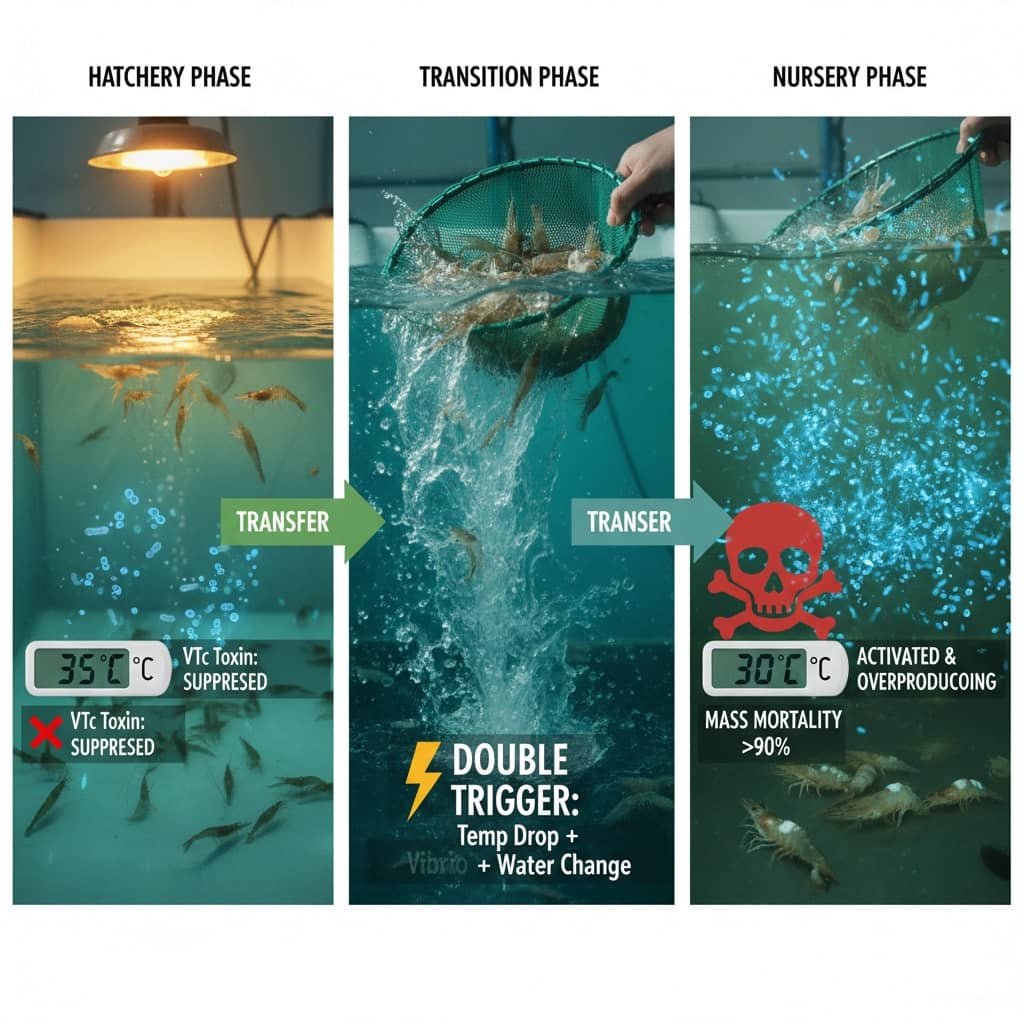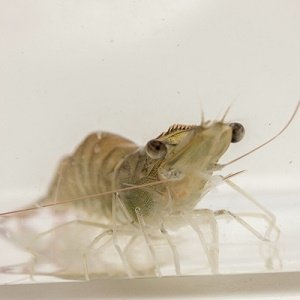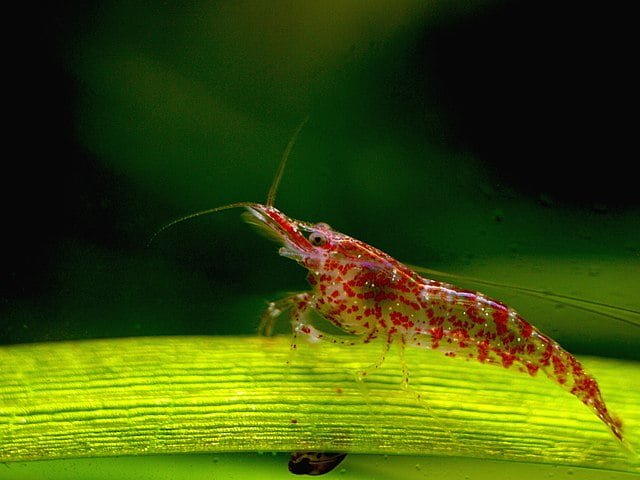
Since its emergence in 2019, Highly Lethal Vibrio Disease (HLVD), also known as Translucent Post-larvae Disease (TPD), has become one of the greatest threats to the shrimp industry. Capable of causing mortality rates exceeding 90% in Penaeus vannamei post-larvae within a matter of days, understanding what triggers its devastating outbreaks is crucial.
We know the culprit is a specific strain of Vibrio parahaemolyticus that carries a potent toxin, designated VTc. However, the pathogen’s presence does not always result in catastrophe. A recent scientific study published by researchers from Jimei University and the Third Institute of Oceanography delved into the environmental factors influencing the bacterium and its toxin, revealing a specific combination of events that acts as the primary switch for disease outbreaks.
Key findings
- The Vibrio parahaemolyticus bacterium that causes HLVD grows under a wide range of conditions, but the production of its VTc toxin is optimal only between 25-30°C.
- Maintaining a temperature of 35°C suppresses the proliferation of the bacterium in the culture water and reduces mortality in shrimp post-larvae to less than 20%.
- The primary trigger for massive HLVD outbreaks is the combination of a temperature reduction (from 35°C to 30°C) along with a water change.
- This scenario mimics the transfer of post-larvae from the hatchery to the nursery stage, explaining the high incidence of the disease at this point.
- Careful management of temperature and water conditions during animal transfers is a fundamental strategy for the control and prevention of HLVD.
What conditions favor the pathogen?
To decipher this puzzle, a research team analyzed how the V. parahaemolyticus strain (vp-HL-202005), isolated from an actual outbreak, responded to different conditions of temperature, pH, salinity, and nutrient availability in the laboratory.
The results showed that the bacterium is quite resilient and can grow comfortably across a broad spectrum of conditions, very similar to those typically found in shrimp ponds:
- Temperature: Bacterial growth was optimal in the 25-35°C range.
- pH: It developed well at pH values between 6 and 9.
- Salinity: It showed good growth in salinities from 5 to 30 ppt.
- Nutrients: Higher availability of nutrients (tryptone and yeast extract) boosted both growth and toxin production.
However, bacterial growth is one thing, and its ability to produce the VTc toxin—the weapon that causes the disease—is another entirely.
Temperature: The double-edged sword for the VTc Toxin
The most significant discovery was the relationship between temperature and toxin production. Although the bacterium can grow well at 35°C, its ability to synthesize the VTc toxin is markedly suppressed at this temperature. The ideal range for the bacterium to actively produce its toxin is narrower: between 25°C and 30°C.
This finding is crucial. It suggests that high temperatures, while allowing the bacterium to be present, may not be enough to trigger the disease, as the production of the toxic agent is limited. This led the researchers to the next phase: simulating real-world culture conditions.
Simulating reality: The experiment that revealed the trigger
HLVD outbreaks often coincide with the transfer of post-larvae from hatcheries, where temperatures are typically high (32-34°C), to nurseries, where the temperature is lower (around 30°C). To test if this change was the trigger, immersion challenge experiments were conducted.
Stay Always Informed
Join our communities to instantly receive the most important news, reports, and analysis from the aquaculture industry.
High temperature as a protective factor
First, they exposed shrimp post-larvae to the bacteria at three different temperatures: 30°C, 33°C, and 35°C.
The results were clear:
- At 30°C and 33°C: The bacterium proliferated rapidly in the water and caused mortality rates exceeding 95% within 72 hours.
- At 35°C: The proliferation of V. parahaemolyticus was inhibited. As a result, shrimp mortality was less than 20%, similar to the unexposed control groups.
This confirmed that maintaining a temperature of 35°C acts as a protective factor, inhibiting the large-scale development of the disease.
The dual trigger: Temperature drop and water change
The next step was to simulate the “hatchery-to-nursery” transition. Post-larvae were exposed to the bacteria at 35°C for 72 hours, where, as expected, mortality was low. The surviving animals were then divided into two groups:
- Group 1 (Temperature change only): The water temperature was reduced to 30°C.
- Group 2 (Temperature + Water change): A complete water exchange was performed, and the temperature was simultaneously lowered to 30°C.
The results of this experiment were revealing. In Group 1, where only the temperature was lowered, the bacterium failed to proliferate, and mortality remained low, around 20%.
In contrast, in Group 2, the combination of the temperature drop and the water change caused the V. parahaemolyticus population to skyrocket. In the following 72 hours, shrimp mortality surpassed 95%.
Implications for shrimp aquaculture management
This study demonstrates for the first time that massive HLVD outbreaks are not caused simply by the presence of the bacteria or an isolated temperature change. The trigger is a combination of factors: primary exposure to the pathogen followed by an abrupt environmental shift, specifically a temperature reduction coupled with a water exchange.
Researchers suggest that during the initial period at 35°C, although the pathogenic Vibrio is suppressed, a microflora is established in the water. By lowering the temperature without changing the water, the pathogen fails to find a favorable ecological niche to compete in. However, by renewing the water, a “blank slate” is created where V. parahaemolyticus, now at its optimal temperature of 30°C, has a competitive advantage to proliferate rapidly, produce its toxins, and cause the disease.
For producers, this research offers clear guidance: the hatchery-to-nursery transition period is a time of maximum risk. Careful management of temperature acclimation and water quality during these transfers is more critical than ever to prevent the activation of this “dual trigger” and protect post-larvae from the devastating effects of HLVD and other diseases affecting marine shrimp.
Contact
Fang Li
Key Laboratory of Marine Genetic Resources, Fujian Key Laboratory of Marine Genetic Resources, Third Institute of Oceanography, Ministry of Natural Resources
Xiamen, China
Email: lifang@tio.org.cn
Reference (open access)
Xu, Z., Zhong, S., Yang, F., & Li, F. (2025). Effects of environmental factors on growth and VTc toxin biosynthesis in Vibrio parahaemolyticus associated with a shrimp disease. Aquaculture Reports, 45, 103127. https://doi.org/10.1016/j.aqrep.2025.103127
Editor at the digital magazine AquaHoy. He holds a degree in Aquaculture Biology from the National University of Santa (UNS) and a Master’s degree in Science and Innovation Management from the Polytechnic University of Valencia, with postgraduate diplomas in Business Innovation and Innovation Management. He possesses extensive experience in the aquaculture and fisheries sector, having led the Fisheries Innovation Unit of the National Program for Innovation in Fisheries and Aquaculture (PNIPA). He has served as a senior consultant in technology watch, an innovation project formulator and advisor, and a lecturer at UNS. He is a member of the Peruvian College of Biologists and was recognized by the World Aquaculture Society (WAS) in 2016 for his contribution to aquaculture.




